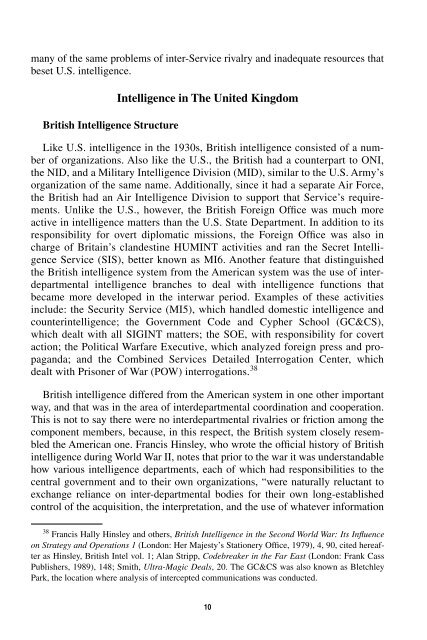assessments. By 1941, ONI was relegated to the position of reporting only factualinformation derived from their various collection sources. This situation was thesource of acrimonious conflict between Turner and the DNI, RADM Kirk. Kirkfought vigorously for the reestablishment of ONI’s preeminent position in theevaluation of intelligence, a position actually spelled out in regulation, but Starkpreferred Turner’s system. 34 The end result was that, by the time Kirk wasrelieved by Rear Admiral Theodore S. Wilkinson in October 1941, ONI was in asubordinate position to War Plans and was often out of the loop on the Navy’soperations and war planning efforts prior to the war. 35Another source of internecine conflict that limited ONI’s effectiveness wasthat which existed between ONI and OP-20-G. Once again, then-RADM Kirkwas at the center of another controversy, this time with the Director of NavalCommunications (DNC), who contended that the DNC, not ONI, should be theoffice to present decrypted “MAGIC” intercepts to the CNO and the Secretary ofthe Navy. 36 While Kirk won this battle and ONI was allowed to continue briefingthe MAGIC decrypts, the conflict created considerable tension between ONI andOP-20-G that lasted through much of the pre-war period and beyond.While ONI’s capabilities were improving in the period just prior to the war, theBritish well understood they were attempting to engage in cooperative partnershipwith an organization they considered inferior. Beesly effectively sums up themajor ONI deficiencies: “Where the Americans were far behind the British was intheir general intelligence expertise, in inter-Service [and intra-Service] cooperationand co-ordination and effective use of results obtained from many differentsources.” 37 Despite its deficiencies, though, ONI became the main conduit for thesharing of intelligence with the British, through its attaché office in London, andwas chosen as one of the main coordinators for technical exchanges between thetwo countries. While the British viewed their system of intelligence as superior tothe Americans, they were also playing catch-up from the under-resourcing of theinterwar period and had their own difficulties to overcome. An analysis of thestate of British intelligence just prior to the war will demonstrate that it shared34Arthur H. McCollum, Reminiscences of Rear Admiral Arthur H. McCollum, U.S. Navy,Retired, 1, United States Naval Academy Special Collections, 328-330, cited hereafter as McCollumReminiscences; Kirk Reminiscences, 179-180, 182; Dorwart, Conflict of Duty, 155-161.35Packard, 23; McCollum Reminiscences, 322-323.36 Kirk Reminiscences, 179; Packard, 22; John Winton, Ultra in the Pacific: How Breaking theJapanese Codes and Cyphers Affected Naval Operations Against Japan, 1941-45 (Annapolis, MD:Naval Institute Press, 1993), 6-7. MAGIC was the code name used for decrypts of the JapanesePURPLE diplomatic code.37Patrick Beesly, Very Special Admiral: The Life of Admiral J. H. Godfrey, CB (London: HammishHamilton, Ltd, 1980), 180. Cited hereafter as Beesly, Very Special Admiral.9
many of the same problems of inter-Service rivalry and inadequate resources thatbeset U.S. intelligence.British <strong>Intelligence</strong> Structure<strong>Intelligence</strong> in The United KingdomLike U.S. intelligence in the 1930s, British intelligence consisted of a numberof organizations. Also like the U.S., the British had a counterpart to ONI,the NID, and a Military <strong>Intelligence</strong> Division (MID), similar to the U.S. Army’sorganization of the same name. Additionally, since it had a separate Air Force,the British had an Air <strong>Intelligence</strong> Division to support that Service’s requirements.Unlike the U.S., however, the British Foreign Office was much moreactive in intelligence matters than the U.S. State Department. In addition to itsresponsibility for overt diplomatic missions, the Foreign Office was also incharge of Britain’s clandestine HUMINT activities and ran the Secret <strong>Intelligence</strong>Service (SIS), better known as MI6. Another feature that distinguishedthe British intelligence system from the American system was the use of interdepartmentalintelligence branches to deal with intelligence functions thatbecame more developed in the interwar period. Examples of these activitiesinclude: the Security Service (MI5), which handled domestic intelligence andcounterintelligence; the Government Code and Cypher School (GC&CS),which dealt with all SIGINT matters; the SOE, with responsibility for covertaction; the Political Warfare Executive, which analyzed foreign press and propaganda;and the Combined Services Detailed Interrogation Center, whichdealt with Prisoner of War (POW) interrogations. 38British intelligence differed from the American system in one other importantway, and that was in the area of interdepartmental coordination and cooperation.This is not to say there were no interdepartmental rivalries or friction among thecomponent members, because, in this respect, the British system closely resembledthe American one. Francis Hinsley, who wrote the official history of Britishintelligence during World War II, notes that prior to the war it was understandablehow various intelligence departments, each of which had responsibilities to thecentral government and to their own organizations, “were naturally reluctant toexchange reliance on inter-departmental bodies for their own long-establishedcontrol of the acquisition, the interpretation, and the use of whatever information38 Francis Hally Hinsley and others, British <strong>Intelligence</strong> in the Second World War: Its Influenceon Strategy and Operations 1 (London: Her Majesty’s Stationery Office, 1979), 4, 90, cited hereafteras Hinsley, British Intel vol. 1; Alan Stripp, Codebreaker in the Far East (London: Frank CassPublishers, 1989), 148; Smith, Ultra-Magic Deals, 20. The GC&CS was also known as BletchleyPark, the location where analysis of intercepted communications was conducted.10
- Page 1 and 2: COURTING A RELUCTANT ALLYAn Evaluat
- Page 4: The Joint Military Intelligence Col
- Page 8 and 9: FOREWORDTo most Americans alive tod
- Page 10 and 11: PROLOGUESince World War II, the Uni
- Page 12 and 13: Chapter 1THE STATUS OF INTELLIGENCE
- Page 14 and 15: action, a propaganda unit, or an ec
- Page 16 and 17: officers assisted by 20 civilian cl
- Page 18 and 19: ships in violation of treaty limits
- Page 22 and 23: might bear on their work.” 39 As
- Page 24 and 25: ility over time, its operational in
- Page 26 and 27: Chapter 2U.S.-UK RELATIONS, 1914-19
- Page 28 and 29: told by the Chief of Naval Operatio
- Page 30 and 31: ups of the early 20th century. 65 T
- Page 32 and 33: firmly believed that British polici
- Page 34: ecame one of the primary sources of
- Page 37 and 38: of shoring up their strategic weakn
- Page 39 and 40: mon framework for negotiation with
- Page 43 and 44: assuaged British concerns about the
- Page 45 and 46: In the area of intelligence exchang
- Page 47 and 48: clear to the Americans that if they
- Page 49 and 50: in his mind worked against closer c
- Page 51 and 52: praised the fighting spirit of the
- Page 53 and 54: through November of 1940 persuaded
- Page 55 and 56: and Great Britain. His principalcon
- Page 57 and 58: eceived by the British and from the
- Page 59 and 60: gear designed by the British. Altho
- Page 61 and 62: American Attitudes On Intelligence
- Page 63 and 64: information did have an impact on K
- Page 65 and 66: the affair. 183 This lack of resent
- Page 67 and 68: tion exchanges. Even more significa
- Page 69 and 70: nation (BSC) mission, is now availa
- Page 71 and 72:
good will and encouraged greater co
- Page 73 and 74:
would merely show Donovan “the be
- Page 75 and 76:
Lothian passed Hill’s proposal to
- Page 77 and 78:
still a powerful influence. While Z
- Page 79 and 80:
Since the Tizard Mission had only a
- Page 81 and 82:
appropriating large increases to th
- Page 83 and 84:
the French, a point which would not
- Page 85 and 86:
equested that RADM Ghormley remain
- Page 87 and 88:
when he [Pott] comes to O.N.I. he i
- Page 89 and 90:
it was not official U.S. policy. St
- Page 91 and 92:
efforts that had begun with the Sta
- Page 93 and 94:
high-level ABC-1 staff talks which
- Page 95 and 96:
to successfully interpret the instr
- Page 97 and 98:
to little more than a nebulous stat
- Page 99 and 100:
to offer.” 319 Others in the Brit
- Page 101 and 102:
Operational Intelligence Cooperatio
- Page 103 and 104:
Godfrey’s main concern was most l
- Page 105 and 106:
possesses complementary capabilitie
- Page 107 and 108:
2. Be prepared to give something of
- Page 109 and 110:
had in forming its own Joint Intell
- Page 112 and 113:
GLOSSARYABC-1ALUSNALondonBGENBSCCAP
- Page 114 and 115:
APPENDIX AA NOTE ON SOURCESArchival
- Page 116:
APPENDIX BMAJOR EVENTS IN U.S.-UK I
- Page 119 and 120:
________. Foreign Relations of the
- Page 121 and 122:
________. “The Secret of the Chur
- Page 123 and 124:
Zacharias, Ellis M., CAPT, USN. Sec
- Page 126 and 127:
INDEXAABC-1 Talks 41, 57, 74-75, 78
- Page 128 and 129:
IImagery Intelligence (IMINT) 12, 8
- Page 130 and 131:
Signals Intelligence(SIGINT) 2-3, 7
- Page 132:
PCN 53512ISBN 0-9656195-9-1
















